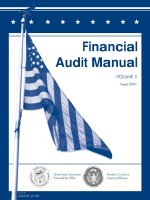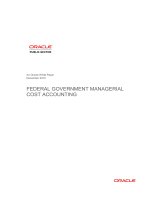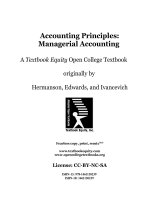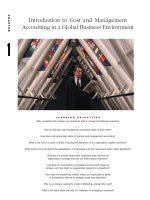FEDERAL GOVERNMENT MANAGERIAL COST ACCOUNTING ppt
Bạn đang xem bản rút gọn của tài liệu. Xem và tải ngay bản đầy đủ của tài liệu tại đây (208.02 KB, 15 trang )
An Oracle White Paper
December 2010
FEDERAL GOVERNMENT MANAGERIAL
COST ACCOUNTING
FEDERAL GOVERNMENT MANAGERIAL COST ACCOUNTING
Executive Overview 2
Introduction 3
The Benefits of Improved Managerial Cost Accounting Information 4
Statutory / Regulatory Compliance 4
Improved Management Information and Decisions 5
Use Case - Shared Services 6
Funding 6
What is Managerial Cost Accounting 7
Managerial Cost Accounting Definition 7
Managerial Cost Accounting Methods 7
Use Case - Working Capital Fund 9
Cost Management Implementation Challenges and Suggested Approach 9
Implementation Challenges 9
Suggested Approaches 10
Oracle’s Solution for Cost Accounting and Cost Management 10
Overview 10
Stages and Dimensions 11
Use Case - Performance-Based Budgeting and Cost Management 12
Easy to Develop Models 12
Trace Assignment Flows 12
Integrated part of a Performance Management System 13
Conclusion 13
FEDERAL GOVERNMENT MANAGERIAL COST ACCOUNTING
2
Executive Overview
Public Sector organizations are constantly challenged to improve their performance in a
resource constrained environment. One key to achieving this goal is a detailed understanding
of the activities performed in support of the organization’s outputs, programs and mission, and
the resources consumed by these activities. To gain this detailed insight and to be able to
trace unit cost per output back to the original source costs, a robust Managerial Cost
Accounting system (MCA) is required. Oracle's cost management solution is an ideal tool to
support the MCA requirements of a Public Sector organization
.
FEDERAL GOVERNMENT MANAGERIAL COST ACCOUNTING
3
Introduction
Government Agencies are constantly challenged to efficiently and effectively utilize resources,
to increase transparency, to expand constituent services and to improve performance. At the
core of addressing these challenges is a requirement for a detailed understanding of the
resources needed and consumed related to goals, mission and outputs of the organization.
This information is needed for management and employees to make decisions that will
effectively utilize resources and improve programmatic performance while at the same time
increasing transparency.
It has proven difficult for many organizations to accumulate and analyze timely, accurate and
auditable cost information that is tied to programmatic outputs and delivered services. This is
usually due to a combination of system limitations (including multiple silos of data, and multiple
reporting and analytic platforms), people concerns (including resistance to or fear of change)
and process issues (including the challenge of fully defining an organization’s outputs and
supporting activities, and encouraging employees to track their resource consumption by
activity/output).
Many organizations have initiated a comprehensive cost management program (including
policy, practice and system improvements in the accounting, budgeting and management
areas) to improve their ability to gather and analyze cost and performance data. Implementing
an integrated managerial cost accounting system can provide the ‘system improvements’
component of the cost management program.
This document provides a guide for what to expect from the successful execution of a
comprehensive cost management program. The first section describes some of the benefits
derived from improved managerial cost accounting information, including adherence to
statutory and regulatory guidelines, improved management information and potential increased
funding. The second section defines managerial cost accounting from a governmental
perspective. The third section discusses some of the challenges of improving managerial cost
accounting, including both system and cultural change issues. The final section describes
Oracle software that has been designed and built to address the specific need for access to
timely, accurate and auditable cost information and to improved decision making.
FEDERAL GOVERNMENT MANAGERIAL COST ACCOUNTING
4
The Benefits of Improved Managerial Cost Accounting Information
Federal Government organizations should expect three main benefits from improved cost information:
1) statutory / regulatory compliance, 2) improved management information and decisions and 3)
continued funding. The benefits of statutory and regulatory compliance include decreased regulatory
oversight and political pressure. Improved management information enables better decisions on the
use of scarce resources, which in turn improve delivery of the organization’s mission. Funding requests
that contain detailed cost justifications tied to performance goals are more likely to be approved.
Statutory / Regulatory Compliance
There are a variety of statutory and regulatory requirements that are driving Federal Government
organizations towards improved managerial cost accounting. These include:
•
The Chief Financial Officers Act of 1990, which includes requirements to support “integration and
modernization of the government’s financial systems and provides for the development of, and
reporting of, cost information.”
1
•
The Government Performance and Results Act of 1993, which “requires agencies to develop
strategic plans and performance goals, and to measure and report on performance compared to
goals. Unit costs and other types of cost information are indicators of performance. Managerial cost
systems will be needed to enable comparisons of actual costs with cost goals and to compare costs
with outputs and outcomes.”
2
•
The Statement of Federal Financial Accounting Standards 4: Managerial Cost Accounting Standards
and Concepts, which states: “In managing federal government programs, cost information is
essential in the following five areas: (1) budgeting and cost control, (2) performance measurement,
(3) determining reimbursements and setting fees and prices, (4) program evaluations, and (5) making
economic choice decisions.”
3
Each of these documents states explicitly or implicitly that the use of government resources must be
properly tracked and tied to an organization’s performance goals. Managerial cost accounting is a
recommended method of achieving this goal.
1
CFO Act of 1990
2
Government Performance and Results Act of 1993
3
Statements of Federal Financial Accounting Concepts and Standards, as of June 30, 2010: The Statement
of Federal Financial Accounting Standards 4: Managerial Cost Accounting Standards and Concepts
FEDERAL GOVERNMENT MANAGERIAL COST ACCOUNTING
5
Improved Management Information and Decisions
While adherence to statutory and regulatory requirements is certainly an important goal for any Federal
organization, the most immediate benefit of managerial cost accounting involves the ability to make
better decisions from better information. Access to timely, accurate, auditable information has been a
problem for many Federal managers. One major cause of this problem is having non-integrated
business systems with the corresponding dual data entry and reconciliation issues. Another cause
involves changing business requirements in the form of new reporting and informational needs.
Whatever the cause, a typical Federal manager does not have access to all the information needed to
make ‘optimal’ decisions regarding resource usage.
By improving their managerial accounting systems, an organization should be able to answer questions
like:
1) What is the cost of delivering a specific product/service, by region, by organization, by constituent,
by time/season?
2) What will be the impact on service levels of a 10% budget cut?
3) How much would it cost to improve service levels 15%?
4) Based upon current spending levels, when will a program run out of funds?
5) How much will it cost to move an organization’s strategic goal from yellow to green status in the
enterprise performance management system?
6) In response to a congressional inquiry, how much money is being spent in support of a new
grouping of programs and activities?
Successful implementation of a managerial cost accounting system provides answers to these types of
questions and the flexibility to answer new questions as they arise.
FEDERAL GOVERNMENT MANAGERIAL COST ACCOUNTING
6
Use Case - Shared Services
Governmental organizations, like many private companies, can attain efficiency and service improvements and achieve ongoing cost
reductions by focusing on a shared services strategy to reduce overlap and redundancy of functions, processes and infrastructure.
When done effectively, Human Capital Management (HCM), Finance, Information Technology (IT), procurement and other support
services can all benefit from a shared services strategy.
Oracle's cost management solution provides the insight needed to thoroughly understand the true costs of shared services. Using
appropriate and representative cost drivers, Oracle's cost management solution determines how to justifiably assign fixed and variable
expenses to shared services, resulting in a better understanding of the cost per service, cost per activity and cost consumption of
resources. This new knowledge allows departments to confidently accept internal fees that they are being charged.
But a well-implemented shared services strategy also permits managers to answer questions such as:
• What are the true costs of my service offerings?
• Are my fee rates set appropriately?
• Do I have enough resources to perform these services?
• If the requirement for this service increases by 30%, do I have the resources to handle it?
• How can I best use my people to most effectively provide these services?
User-defined shared services models in Oracle's cost management solution help answer these questions, and many more. Scenario
playing capabilities allow cost analysts to evaluate the impact on cost and resources of performance improvements, service volumes
changes, and/or rates changes.
New knowledge of activity and resource costs can also be used in the budget process to justify funding requirements for future periods.
Funding
Due to statutory/regulatory requirements, future funding requests are evaluated based upon an
organization’s ability to achieve performance goals and clearly establish the associated costs.
Organizations that can clearly monitor performance and the associated resource costs are much more
likely to receive the funding requested than organizations without this information. This is true for
both appropriated and reimbursable type funding.
Organizations that rely on reimbursable funding are constantly challenged by their customers to detail
and justify their costs. This issue can translate to a potential loss of funding, as customers are
sometimes reluctant to reimburse costs without the auditable backup data.
Organizations requesting appropriated funds are also challenged to justify their funding requests with
detailed cost information, including cost per output and cost per performance (e.g., Earned Value
Management EVM). The OMB Exhibit 300
4
(capital assets) and Exhibit 53
4
(information technology)
4
CIRCULAR NO. A–11 PREPARATION, SUBMISSION, AND EXECUTION OF THE BUDGET
Executive Office of the President Office of Management and Budget July 2010
FEDERAL GOVERNMENT MANAGERIAL COST ACCOUNTING
7
are two examples of documents that support funding requests which require complete and accurate
cost data.
What is Managerial Cost Accounting
With the need for improved managerial cost accounting information established, it is important to
define cost accounting, including its evolution over time.
Managerial Cost Accounting Definition
In the CFO Council/JFMIP Cost Accounting Implementation Guide, the following definition for
managerial cost accounting is provided:
“Managerial cost accounting is the process of accumulating, measuring, analyzing, interpreting, and
reporting cost information useful to both internal and external groups concerned with the way in
which the organization uses, accounts for, safeguards, and controls its resources to meet its objectives.
Managerial cost accounting is therefore the servant of budgeting, financial accounting, and reporting
because it assists those functions in providing information. In addition, managerial cost accounting
provides useful information directly to management.”
5
In the AGA CPAG Research Series on Managerial Cost Accounting, the following description for
managerial cost accounting (MCA) is provided:
“MCA involves the accumulation and analysis of financial and nonfinancial data, resulting in the
allocation of costs to organizational pursuits such as performance goals, programs, activities and
outputs.”
6
To summarize, managerial cost accounting is the process of assigning costs to cost objects (outputs) to
support an organization’s management information requirements.
Managerial Cost Accounting Methods
Guidance has been provided regarding cost assignments and costing methods. From SFFAS 4, “The
cost assignments should be performed using the following methods listed in the order of preference:
(a) directly tracing costs wherever feasible and economically practicable, (b) assigning costs on a cause-
and effect basis, or (c) allocating costs on a reasonable and consistent basis.”
7
The costing
5
JFMIP Managerial Cost Accounting Implementation Guide – February 1998
6
AGA CPAG Research Series: Report No. 22, September 2009: Managerial Cost Accounting in the Federal
Government: Providing Useful Information for Decision Making
7
Statements of Federal Financial Accounting Concepts and Standards, as of June 30, 2010: The Statement
of Federal Financial Accounting Standards 4: Managerial Cost Accounting Standards and Concepts
FEDERAL GOVERNMENT MANAGERIAL COST ACCOUNTING
8
methodology used should be appropriate for management’s needs and the operating environment.
8
There are a variety of acceptable costing methods, including:
•
Standard Costing, where standard cost rates are established based upon historical data (or some
other reasonable source). This costing methodology is most appropriate for repetitive type outputs
(e.g., widgets delivered) and relies on on-going comparisons with actual costs to identify any material
variances (which would lead to rate adjustments).
•
Job Order Costing, where discrete units of work are identified and used to accumulate the
appropriate direct costs (via direct assignment) and indirect costs (based upon a causal beneficial
relationship). This costing methodology is most appropriate for organizations that produce non-
repetitive outputs (e.g., case management, engineering and construction, research and development).
•
Process Costing, where products are created by flowing through a series of organizations/steps,
accumulating a unit cost as they flow from one step to the next. This methodology is most
appropriate for the production of homogeneous goods or services, where the same process is used
in the production of each output (e.g., Medicare claims processed).
•
Activity Based Costing (ABC), where the cost of an output is determined by the activities required to
produce the output and the resources consumed by these activities. This methodology is most
appropriate for organizations that can clearly define their outputs, activities and cost drivers (used to
assign resource costs to activities). The major benefits of ABC are: 1) improved accuracy of cost
assignments (by more accurately assigning both indirect and direct costs) and 2) identification of
non-value added activities (those activities that do not directly or indirectly support an organization’s
outputs).
Each organization must determine the optimal methodology to be used, based upon their specific
situation. It is important to note that the methodologies are not mutually exclusive. It is appropriate to
utilize more than one methodology in some circumstances.
For organizations that want an even greater understanding of outputs, it is necessary to bring new
insights to inputs assigned to programs. It is important to analyze the input costs or resources assigned
to each activity pool, and define and articulate the logic used to create and model cost assignment
drivers. Successful management accounting systems are able to utilize these models to show the flow
of costs from resources to activities to outputs, or from outputs back to activities and resources. This
ability to provide the management accounting information in a simple to follow, graphical way,
addresses many of the adoption and implementation challenges that can cripple a cost management
initiative. The managerial cost accounting system should also be able to support scenario based
8
Statements of Federal Financial Accounting Concepts and Standards, as of June 30, 2010: The Statement
of Federal Financial Accounting Standards 4: Managerial Cost Accounting Standards and Concepts
FEDERAL GOVERNMENT MANAGERIAL COST ACCOUNTING
9
analysis, which enables managers to choose from a variety of approaches, the approach that is best for
the organization.
Use Case - Working Capital Fund
Working Capital Funds (WCF) are revolving funds that rely on cost recovery to finance operations. The revolving funds are designed to
be zero-profit/loss activities. In other words, the full costs (and only the full costs) of the products and services delivered is to be
reimbursed through the associated sales. Many WCF organizations use stabilized rates to bill customers for the associated products
and services. These stabilized rates enable customers to accurately plan for the costs associated with the products and services they
intend to procure, during a given budget cycle. The ability to accurately plan expenditures is critical for any government organization.
Since WCF organizations intend to fully recover their costs while utilizing stabilized rates, it is critical that these rates be as accurate as
possible. If the rates are set too high or too low, the organizations will over recover or under recover. To accurately set rates, they need
to have a comprehensive understanding of the products/services they deliver, the activities and tasks required for production/delivery
and the resources consumed by those activities.
Oracle's cost management solution is an ideal solution to support the needs of a WCF organization. It enables the modeling of
products and services and establishes the relationship back to the corresponding activities and resources. With this information,
organizations not only understand the true costs of their outputs, they can also analyze the related activities so that they can make
informed decisions related to controlling costs, and can establish and compare benchmarks for certain industry standard activities.
Cost Management Implementation Challenges and Suggested
Approach
Implementation Challenges
Implementing a managerial cost accounting system (including software and business process
improvements) can significantly improve the management information available to a Federal
organization Due to the nature of the work, the most significant challenge is likely to involve the ability
to address the cultural/organizational issues that will arise during implementation and deployment.
These issues include:
1) Standards - agreement upon outputs, cost objects, business process and other implementation
related items.
2) Time keeping - individuals may be asked for the first time to document what they are doing and
how much time they spend doing it.
3) Access to information - revealing detailed cost/schedule/performance problems hidden by current
system limitations.
4) Domain expertise - individuals feel that their value to the organization is tied to their unique
knowledge of and ability to work the current systems.
5) Comfort level - individuals feel (correctly) that the new system will initially have an adverse effect
on performance and productivity and that the new system will require them to change how they
currently do their job.
FEDERAL GOVERNMENT MANAGERIAL COST ACCOUNTING
10
6) Survival - the new system will make jobs/roles unnecessary and therefore expendable.
The most common cause of failure for a system implementation is the cultural and organizational
issues that arise. It is imperative that a plan be established to identify and address these issues before,
during and after the deployment.
Suggested Approaches
One of the difficulties in improving an organization’s understanding of their costs is defining where to
begin. You ‘don’t know what you don’t know’. Another challenge is the time and resources it takes to
execute a major cost management initiative, especially given the organizational and cultural challenges
mentioned above.
For this reason, it is often valuable to start small and adopt a phased approach to improved managerial
cost accounting. Some potential good first phases include:
1. Enterprise repository of current cost data (this would involve pulling together disparate cost data,
in its current format, into a central repository for analysis)
2. A shared service center
3. A working capital fund organization
4. A major program office
5. A specific department that is interested in taking a leadership role in the managerial cost accounting
efforts.
Starting with any of the five areas mentioned above can jump start the cost management process by:
a) Highlighting areas where there appear to be significant source data accuracy issues (which can be
researched and fixed at their source).
b) Identifying areas where the costs are highest (i.e., focus on the most material areas).
c) Minimizing the organizational and cultural issues that bog down larger implementations.
d) Providing the organization with the near term value of having improved managerial cost accounting
information in the selected business area.
Future phases can then target those areas deemed most critical to the organization. With this
incremental approach, the organization can derive near term value and then produce incremental
improvements, focusing on the high value targets first.
Oracle’s Solution for Cost Accounting and Cost Management
Overview
Oracle's newest cost management solution, Oracle Hyperion Profitability and Cost Management
(HPCM) is designed to enable Federal agencies to easily extend their cost accounting capabilities by
FEDERAL GOVERNMENT MANAGERIAL COST ACCOUNTING
11
enabling them to discover the drivers of cost, empowering their program and department managers
with increased visibility into cost flows and enabling them to improve resource alignment with agency
objectives and outcomes.
The models developed within HPCM reflect the agency and its operational structure. The models can
include a wide range of flexible assignment methods and easy to build allocation rules.
Validations, including balancing reports and process checks are built in. Transparency and visibility
ensure quick model development and enable easily sharing of the concepts and logic with a wide
audience. This is very important in explaining the relationships between outcomes, outputs and inputs,
and fills an existing knowledge gap.
Supporting these features are robust analysis and reporting capabilities, including traceability maps
within the models showing exactly what is going on at every point of the model.
Stages and Dimensions
Some programs, departments, functions and processes within a given Federal agency are easy to model
due to the direct relationship between the inputs, activities and outputs. This happens where there are
dedicated or specialized people, processes or tasks. But there will also be many areas where more
complex, multi-stage modeling assignment logic is needed.
A flexible solution that can provide both approaches is needed. With HPCM the number and
simplicity or complexity of the model stages and how to assign the inputs across the dimension and
stages are fully user definable.
There is no need to follow a prescribed, rigid, single modeling path. For example, if most inputs costs
go from the second to the third stage, but some need to go from the first directly to the third in the
model, the solution is open and flexible so as to accommodate this. It will support the way an agency
structures its operations. Being forced into a one-size fits all model is a big implementation challenge,
and HPCM avoids this pitfall.
FEDERAL GOVERNMENT MANAGERIAL COST ACCOUNTING
12
Use Case - Performance-Based Budgeting and Cost Management
Performance-Based Budgeting seeks to improve the efficiency and effectiveness of public expenditures by linking the funding of public
sector organizations to the results they deliver. With this method of budgeting, it is possible to shorten the planning and reporting
cycles, to tie agency performance to budget, and to deliver continuous performance improvement across an entire government agency.
Aligning departmental objectives with organizational goals and measuring agency performance against targets results in an enhanced
strategic planning process and improved accountability for results.
To produce a practical budget for maintaining acceptable service levels, it is important to understand the real costs associated with the
activities performed, and with the services and programs provided. Using allocation methods determined by the agency, Oracle's cost
management solution assigns costs of direct and shared resources to the activities, services and programs that actually consume them.
Its traceability illustrates graphically how the resulting per-activity or per-service costs have been built up and provides a means to
justify these cost assignments to internal and external stakeholders.
Activity cost results in Oracle's cost management solution provide valuable input to the planning process to help develop or adjust
budgets and forecasts on an on-going basis. The availability of justified unit costs typically reduces the number of iterations required in
the planning process and the time required to evaluate multiple scenarios. Plus results distributed through dashboard or scorecard
visualizations highlight variances – positive variances indicating the attainment of better efficiencies, or negative variances exposing a
challenge to be dealt with.
Performance-Based Budgeting aims to evaluate programs by measuring the relationship between resources consumed and results
provided. Oracle's cost management solution provides agencies with the realistic cost information to defensibly make these
comparisons.
Easy to Develop Models
Functional business users can do the modeling with technical business users providing financial and
driver data sets. The way an organization does things can be reflected in the model because it defines
all the elements – it is not a black box modeling environment. Allocation rules are both easy to build
and maintain. There are also multiple rules types and built-in validation reporting.
Embedded validation enables rapid prototyping and fast development of alternative scenarios.
Modeling progress is validated through the validation processes and report screens.
Many cost accounting and cost management initiatives get bogged down in overly technical project and
implementation challenges that alienate the business and technical teams. The simple, business user
focus of HPCM modeling makes for a straight forward modeling experience.
Trace Assignment Flows
Trace Allocation reports built into HPCM provide visualizations of the cost assignments, so a modeler
can see the interrelationships and confirm the logic. More importantly, they allow the modeling team to
easily show and explain the approach, the methodology, the financial numbers and the impact of the
solution results to a wide audience
FEDERAL GOVERNMENT MANAGERIAL COST ACCOUNTING
13
One of the hardest challenges to address with new performance management initiatives is to get the
new solution and the information it provides understood and adopted by the organization. It’s one of
the key implementation challenges. The visualizations are incredibly valuable in addressing this huge
challenge to success.
There is a potentially wide audience for the new management information provided by HPCM that
goes beyond getting the information out and developing buy-in within the agency. The new
information has to go further to realize the full potential of the new solution.
Regulators, auditors, watchdog and consumer group leaders can also benefit immensely from this clear
visualization of the relationships between outputs supporting outcomes, and resources being allocated
to and consumed by the activities performed. This also supports statutory reporting requirements, as
well as being invaluable information for funding discussions.
Integrated part of a Performance Management System
Federal Agencies require a system that delivers accurate, timely reporting of financial and operational
results. Management, partners, and regulators need to review and understand these reports. Federal
Agencies must accurately predict future outcomes, make confident decisions, and efficiently allocate
resources. To meet all their requirements, they need the transparency and visibility that only a fully
integrated system can deliver.
HPCM is part of Oracle’s Hyperion Performance Management Applications suite, which is a modular
suite of packaged enterprise performance management (EPM) applications that unite goal-setting,
modeling, planning, monitoring, analysis, and reporting into a single, integrated system. The suite
supports closed-loop EPM by delivering an accurate representation of past results and enabling swift,
confident planning and execution for the future. Oracle’s Hyperion Performance Management
Applications provide a unified view of financial and operational performance, so organizations can
quickly and accurately model, plan for, and overcome new challenges.
Conclusion
Government Agencies are constantly challenged to efficiently and effectively utilize resources, to
increase transparency, to expand constituent services and to improve performance of programmatic
goals. For many, it is difficult to accumulate and analyze timely, accurate and auditable cost
information that is tied to programmatic outputs and delivered services. To address the need for
improved cost information, many organizations have initiated a comprehensive cost management
program (including policy, practice and system improvements in the accounting, budgeting and
management areas) to improve their organization’s ability to gather and analyze cost and performance
data. Oracle's cost management solution, HPCM, an integrated managerial cost accounting system,
provides the ‘system improvements’ component of the cost management program and, along with the
other elements of Oracle Enterprise Performance Management System, delivers an integrated solution
to performance improvement.
FEDERAL GOVERNMENT MANAGERIAL
COST ACCOUNTING
December 2010
Authors: Josh Kahn, Toby Hatch, John
Fitzmaurice, Denis Desroches
Oracle Corporation
World Headquarters
500 Oracle Parkway
Redwood Shores, CA 94065
U.S.A.
Worldwide Inquiries:
Phone: +1.650.506.7000
Fax: +1.650.506.7200
oracle.com
Copyright © 2011, Oracle and/or its affiliates. All rights reserved. This document is provided for information purposes only and the
contents hereof are subject to change without notice. This document is not warranted to be error-free, nor subject to any other
warranties or conditions, whether expressed orally or implied in law, including implied warranties and conditions of merchantability or
fitness for a particular purpose. We specifically disclaim any liability with respect to this document and no contractual obligations are
formed either directly or indirectly by this document. This document may not be reproduced or transmitted in any form or by any
means, electronic or mechanical, for any purpose, without our prior written permission.
Oracle and Java are registered trademarks of Oracle and/or its affiliates. Other names may be trademarks of their respective owners.
AMD, Opteron, the AMD logo, and the AMD Opteron logo are trademarks or registered trademarks of Advanced Micro Devices.
Intel and Intel Xeon are trademarks or registered trademarks of Intel Corporation. All SPARC trademarks are used under license
and are trademarks or registered trademarks of SPARC International, Inc. UNIX is a registered trademark licensed through X/Open
Company, Ltd. 12/2010









